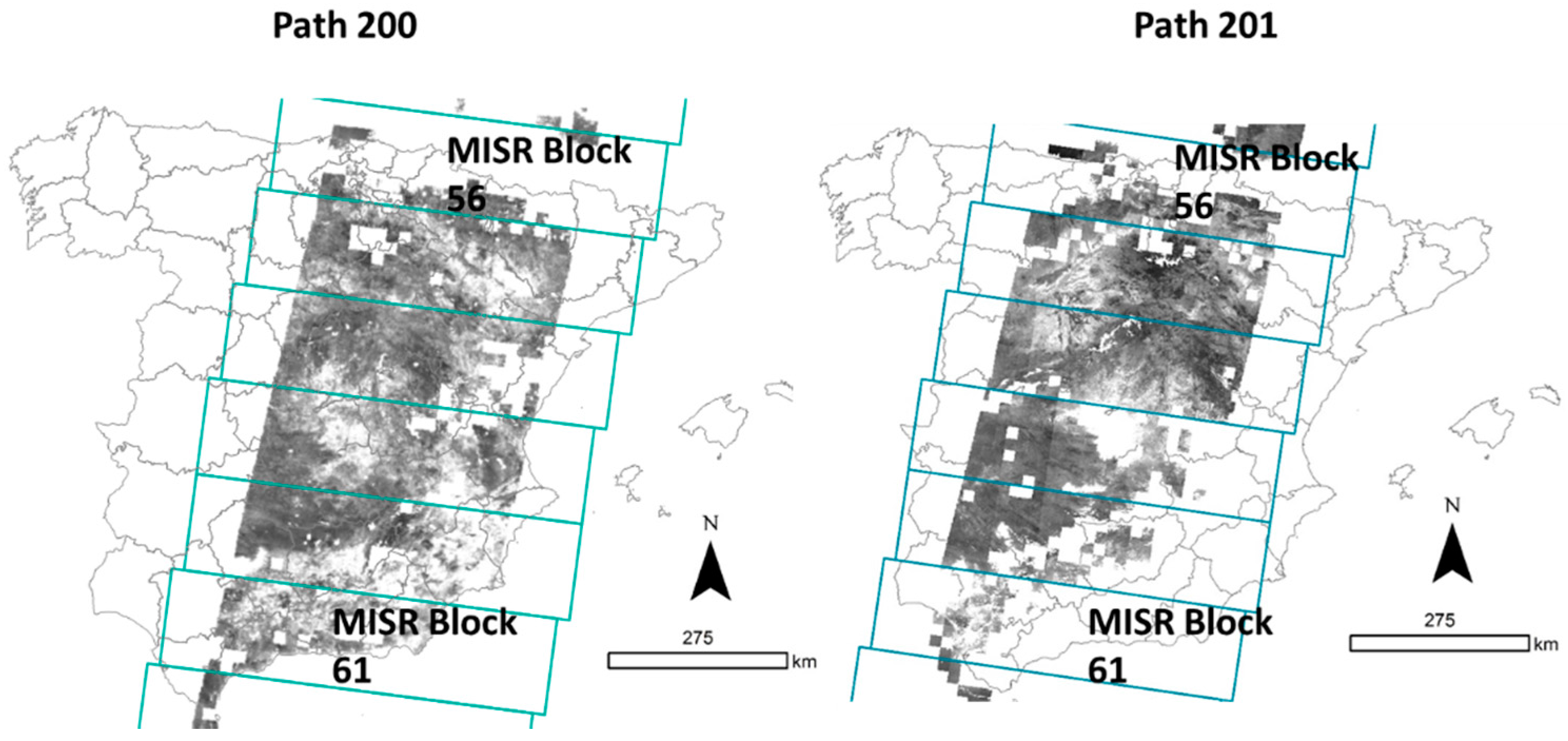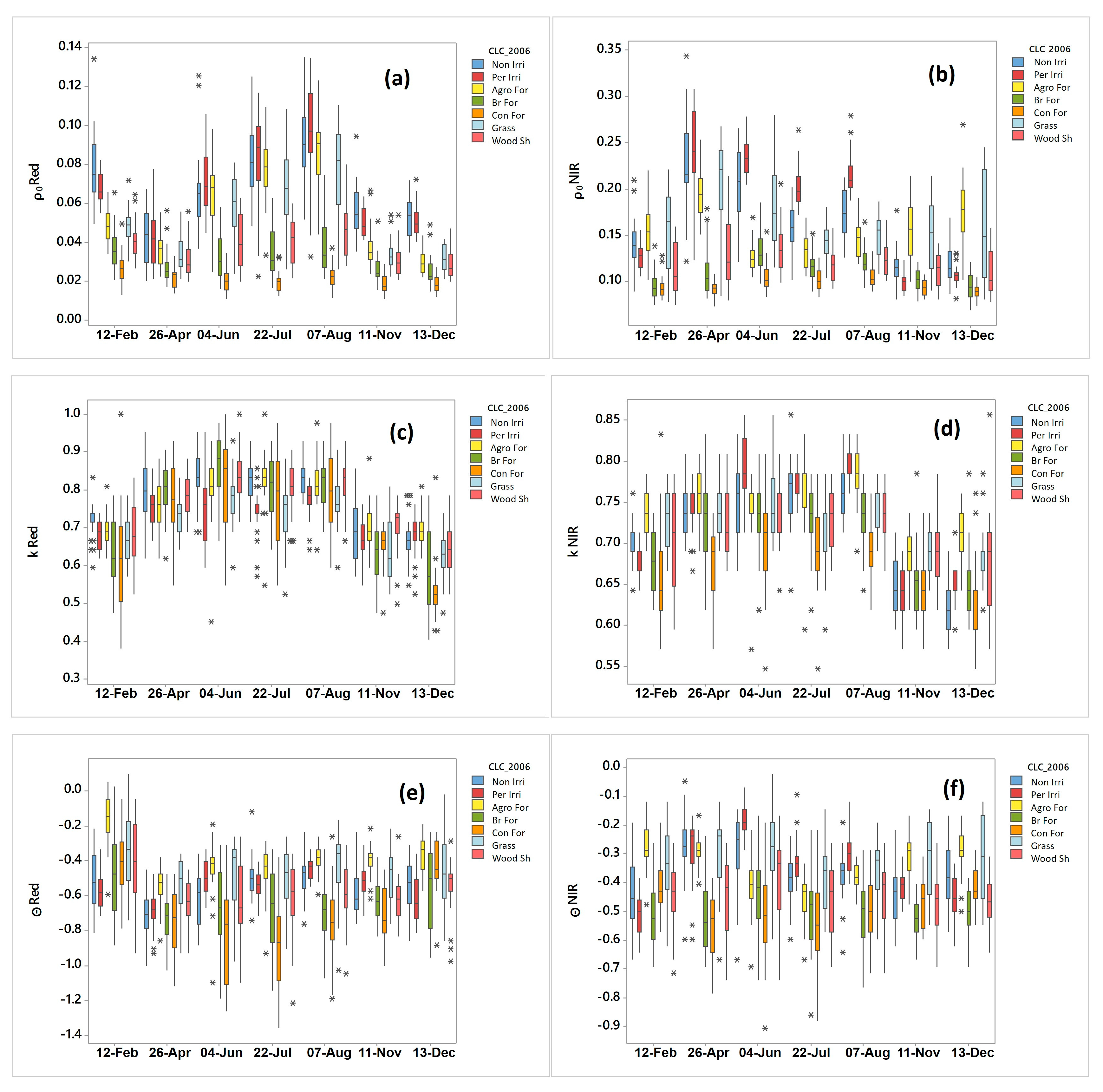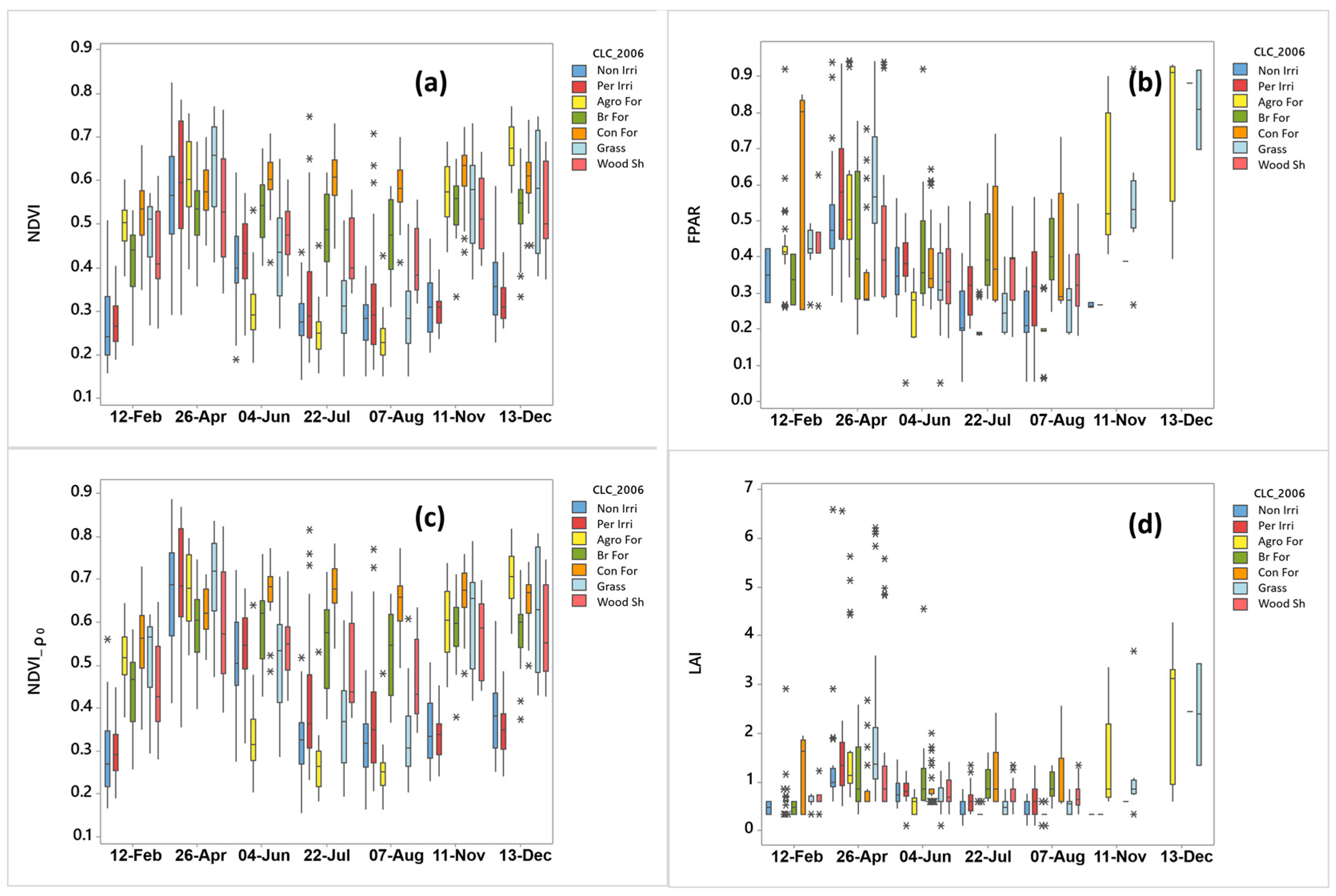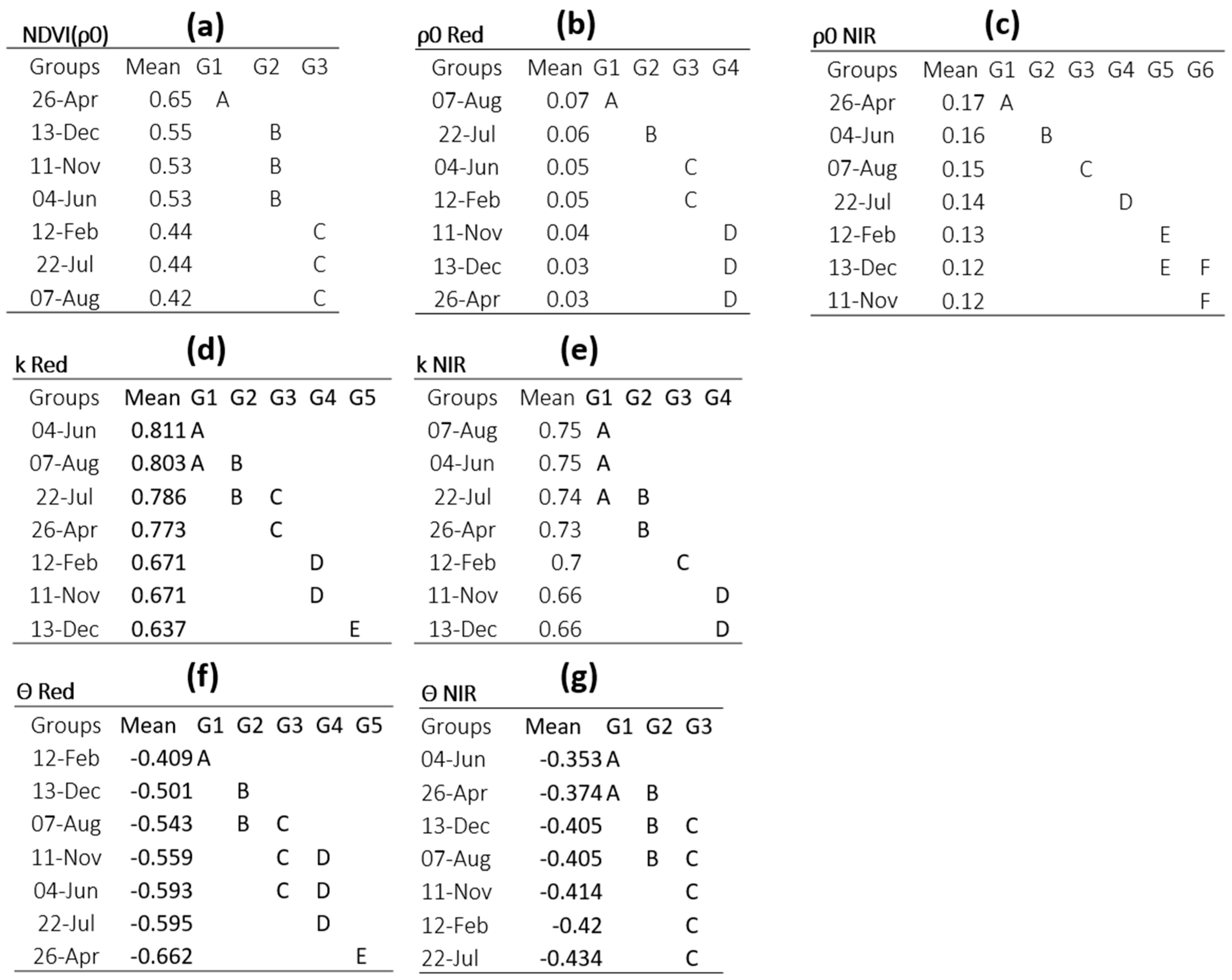3.1. Rahman–Pinty–Verstraete Modified (MRPV) Model Parameters Behavior in Different Land Uses and Captures in Mainland Spain
Figure 2 shows the ρ0, Θ and k values in the red and NIR spectral bands of MISR orbits from 2006 in different classes of land use CLC for Peninsular Spain.
The ρ0 red values from the MISR scenes ranged between 0.01 and 0.14, while those related to ρ0 NIR were between 0.05 and 0.35. Meanwhile, the k red average values were from 0.35 to 1, and, for the k NIR, oscillated between 0.5 and 0.9. Finally, the average values of Θ in the spectral band of red were between –0.1 and –1.4, and those found in the NIR band were from 0 and –0.9 (see
Figure 2).
After reviewing the values presented by other authors (who have also worked with the parameters of the MRPV model), we verified that the values reported in our study coincided with those examined in the literature [
25,
37,
38].
The graphs in
Figure 2 show that the k values were never greater than one; furthermore, the Θ parameter values were always negative. The latter indicated a predominance of backscattering [
26,
37,
38]. Pinty et al. [
17] were the first to report how the anisotropic character of terrestrial targets is influenced by the structure and density of vegetation on a sub-pixel scale. The authors of the papers cited before demonstrated how, for a light soil with dark and vertical vegetation, the presence of trees at medium-high densities created a bell shape (values on the BRF curve along the viewing angles). This pattern was observed in the red spectrum, as in NIR, this spectral contrast between the bright background and the trees occurred on the contrary [
17]. The k values less than one indicated how the BRF curve, along the zenith observation angles, presented a bowl shape, the most common in natural land covers overall, at a 1.1-km spatial resolution [
26]. This parameter was highly dependent on spatial resolution, and when we have a medium resolution (as the MIL2ASLS product is), it appeared harder to find the bell form BRF curve [
26], which occurred in our results.
On the one hand,
Figure 2 shows how parameter ρ0, in the Br For, Con For, and Wood Sh CLC categories, presented more similar median values in all the MISR orbits than the other land cover classes. These results were consistent with those exposed by Alcaraz-Segura [
39], who used NDVI values in the Iberian Ecosystems, instead of ρ0 ones.
Figure 2 also shows how the average values from the Con For CLC were still more similar in the study of MISR orbits than values belonging to Br For, or even more so than those belonging to Wood Sh. This is because Con For on the CLC 2006 map is more homogenous than Br For CLC, which does not show separate deciduous and evergreen plants. The last point explains the fact that, in
Figure 2a,b, we can observe ρ0 red and NIR values from Br For CLC with more dispersion within the same orbit (interquartile range found in the boxplots) than in Con For CLC. Additionally, this also explains the fact that we could see more steady behavior in the values of ρ0 red and NIR pixels belonging to the Br For and Wood Sh CLC categories.
In
Figure 2a,b, it can be seen how the crops (Non Irri, Per Irri), pasture (Grass), and agroforestry (Agro For) CLC ρ0 red, as well as ρ0 at NIR values, presented more variability through the MISR orbits, taken on seven different dates, than the Br For, Con For and Wood Sh classes did. In general, the trend of the ρ0 red and NIR values seemed to be related to the land covers phenological pattern. To further investigate this idea, we focused on
Figure 3, which shows four graphs with the NDVI, FPAR, NDVI calculated using the ρ0 red and NIR values (in
Figure 2a,b) and the LAI variables. From
Figure 3a,c, the median and the interquartile ranges were extracted, and, in general, the behavior of the ρ0 and NDVI values along the seven MISR orbits were quite similar. The FPAR (
Figure 3b) and the LAI value (
Figure 3d) dispersion within one CLC and orbit were higher than the dispersion taken using NDVI (
Figure 3a) and NDVI from ρ0 (
Figure 3c). However, the median values that demonstrated the behaviors of these four variables (
Figure 3) were similar. Thereby, in general, it can be noted that the mean values may support the idea that the ρ0 parameter has a relationship with spectral properties and land cover phenological features, as other authors have already described [
19,
25].
The k parameter in the NIR and the red band seemed to present lower median values in the orbits belonging to winter and autumn than in those of summer and spring (this fact was slightly more marked in the red wavelength than in the NIR one). That is to say, the covers present, in general terms and from the k parameter, a more isotropic behavior (k values close to the unity) from the dates in summer and spring than in those of autumn and winter. Furthermore, the zenith angles from the MISR scenes used here were higher in the winter images than in those belonging to summer and spring, as seen in
Figure 4.
The parameter k shows the difference between observing BRF from the nadir camera in comparison to the BRF from other positions, further away from this nadir position [
18,
40]. The fact that finding average values of k expressed greater anisotropy in the winter and autumn schemes than in summer and spring indicated the influence of the zenith illumination angle on these values. That is, in winter, the sun position is farther from the zenith than in spring and summer. This fact also implied that, in winter and autumn, the sensor captured much more shade from the nadir in comparison with other positions more distant from it, than in summer and winter. Thereby, it could be found greater anisotropy expressed by k in winter and autumn than in summer and spring. The influence of the zenith angle of the data collection on the values reached by k has already been reported in Pinty et al. [
17] or in Reference [
37]; furthermore, their results coincided with those presented in our current work.
From
Figure 3c,d, it can be seen that the k parameter values did not follow the same behavior as ρ0, NDVI, FPAR, and LAI, i.e., the values reached by k did not seem to be dependent on the phenology.
Figure 2e,f shows the Θ parameter pixel values in the different orbits and CLC categories used in this study. The Θ values given from the land use classes in the seven MISR orbits were more anisotropic in the red band than in the NIR, i.e., the values reached were lower in red than in NIR. This fact was due to the effect of multiple dispersion on the NIR channel, which caused the anisotropic behavior to be less than in the red band. This physical effect was observed and explained by Sandmeier et al. [
32]. Furthermore, these results were consistent with those obtained by Armston et al. [
19], where the authors studied different natural covers and dates in Queensland, Australia, and found this effect on bare soil, as well as in soil in addition to vegetation.
A comparison of these graphs (
Figure 2e,f) to the NDVI, FPAR, and LAI ones (
Figure 3) showed that the trends that followed the median and the interquartile ranges of each variable were not very similar. For instance, the Θ red and NIR values of the Grass CLC category appeared to be steadier through the orbits than the others. The Θ red values of the Br For CLC class were slightly more stable through the orbits than the values belonging to the Con For CLC category; however, the NDVI plot (
Figure 3a) occurred on the contrary.
With regards to the anisotropy described by the Θ parameter in our study, it could be appreciated how the Br For and Con For CLC categories were those that presented Θ values more different than zero, i.e., they were the most anisotropic from the perspective of the Θ parameter. Camacho de Coca et al. [
41] explained that the natural land covers made up of vegetation with a predominance of vertical structure 3D were the most anisotropic, and even more so when the background was bright. For that reason, it also explained why we found that the values of the Θ parameter were even more different than zero (more anisotropic) in the orbits used that belonged to summer or near summer. It is in those orbits where the background as the driest of all seven dates used for this study (see
Figure 2e,f).
3.3. Inferential Statistics
Table 6 shows the results of the linear model regressions and the parametric analyses of variance performed using the MRPV parameters (Y) and the categorical variables, named MISR orbit and CLC category (X
n).
Table 7 presents the results from the non-parametric test of variance. At a glance, the results showed how the two categorical variables explained the parameters in a significant way (
p < 0.01) (see
Table 6). The models yielded adjusted R-square values, which rated between 0.37 and 0.74. Taking both the adjusted R-square and F statistics values into account, it appeared that the relationship between the parameters and the MISR dates and CLC category was stronger in the case of ρ0 than in the k, and was weakest in the models explaining the Θ parameter.
All analysis of variance performed showed significantly different mean and median using Orbit, CLC, and Orbit and CLC (see
Table 6 and
Table 7). The resulting F from the parametrically analyses of variance, as well as the Chi-square results from the non-parametrically analyses of variance (see
Table 6 and
Table 7) were higher for the CLC than for the MISR orbit factor in tests related to ρ0 and Θ, and was the opposite in the case of the k parameter test. The NDVI F and Chi-square values were similar between the CLC and Orbit cases.
For the post hoc test performed using the CLC categories shown in
Figure 5, the results illustrated that the majority of these groups were significantly different, using NDVI (ρ0) mean values. This was a good result, since the aim was to use this parameter, for instance, to separate between land covers, but was not a striking finding, as NDVI has already been utilized in some studies [
35] to classify or to detect changes in the land uses. For this reason, we focused on the pair of images that did not significantly differ from the mean NDVI (ρ0) values. These pairs were built using the Wood Sh and the Grass (transitional woodland-shrub and natural grassland), and the pair formed by the Non Irri and Per Irri (non-irrigated arable land and permanently irrigated arable land) CLC categories.
Table 7 shows, on the one hand, that the pair conformed by Wood Sh and Grass were significantly different from the mean values of the k red and NIR and by the Θ red and Θ NIR. On the other hand, the pair built by Non Irri and Per Irri differed statistically from the mean values of the k red. Thus, these results may indicate that the k and Θ parameters from the MIL2ASLS product, in addition to ρ0, which matched well with classical NDVI (like the results shown in
Section 3.2), could help to differentiate between those land covers, which are difficult to differentiate with NDVI even, including data for different seasons of the year.
For the post hoc test performed using the MISR orbit (
Figure 6a) it can be seen that the NDVI (ρ0) values were grouped into three categories. The first category was made up of the MISR orbit from April, which presented the highest mean value, the other was made up of the orbits from December, November, and June. Finally, the last category was confirmed by the orbits of February, July, and August which showed the lowest value of NDVI (ρ0). Effectively, the vegetation in those three categories, in general, presented very marked different phenological behaviors within Mainland Spain. However, for the k and the Θ parameter, the classes resulting from the post hoc test were not conformed in the same way as in the NDVI (ρ0).
In general, the parameter-band CLC categories in the different studied orbits had a high degree of separability, at least given that the mean values belonged to its CLC or orbit. This is why other authors have included multi-angular information in their work on the classification of images, among other utilities. For example, Brown et al. [
42] observed how the inclusion of multi-angular information, in addition to only multi-spectral from the POLDER sensor, produced an improvement in the overall accuracy of close to five percent, achieving a maximum improvement between the classes of wooded savanna and grassland. On the other hand, Mahtab et al. [
43] also obtained increases in the degree of separability of classes, introducing multi angular information in addition to multispectral. Su et al. [
44] increased the overall accuracy by 10–15% using multi-angle information, which was also used to classify between different types of coverage. MIL2ASLS with its MRPV parameters provide us with a source of multi spectral and multi angular information that can be successfully used for great- and medium-scale land cover studies. This is because this product provides a multispectral view of classical remote sensing, thanks to the ρ0 parameter, and, on the other hand, a multi-angular view with the k and Θ parameters.











